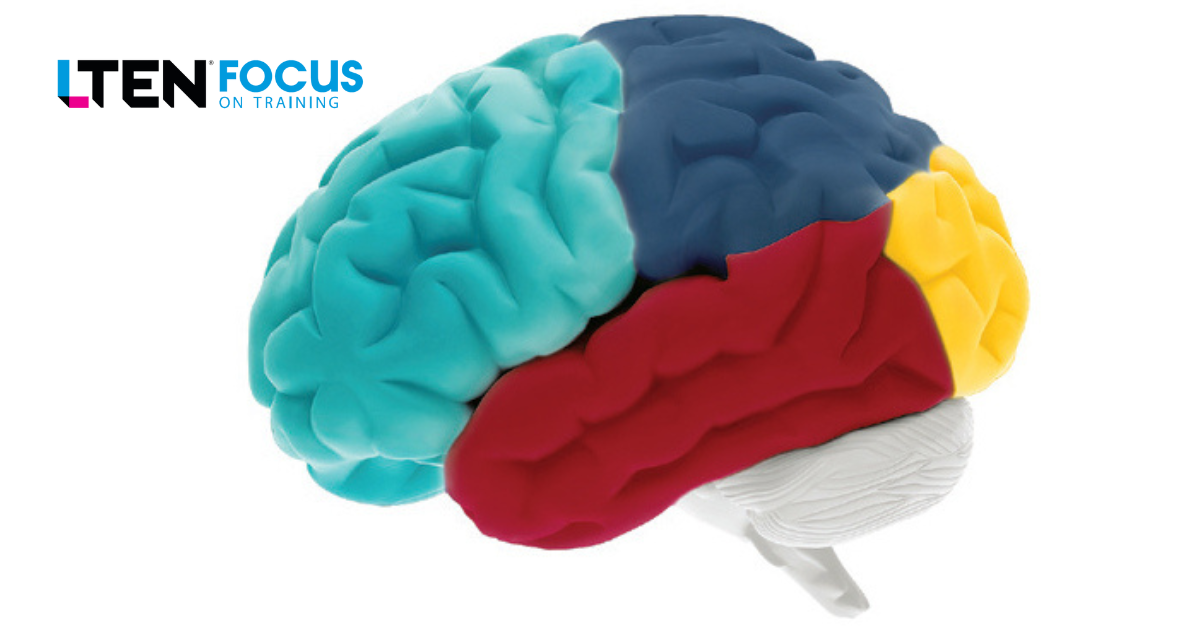
SCIENCE OF LEARNING – By Jennifer Little-Fleck
If you learn to speak brain, you can teach anyone anything
We’ve learned more about how the brain learns in the past 30 years than in the previous 300 years combined, largely due to advances in functional magnetic resonance imaging, or fMRI. Through neuroscience research, we’ve begun to unlock the secrets about how the brain learns, retains and retrieves information.
It’s as if we’ve been given a map to previously uncharted territories of the mind. This information has not only taught us what is happening in the brain, but also busted some learning myths.
Myth #1: The brain is a static organ.
This myth has been busted by the discovery of neuroplasticity; the brain’s amazing ability to reorganize itself by forming new neural connections throughout life, constantly reshaping itself in response to new experiences and learning.
Myth #2: You’re born with all the brain cells you’ll ever have.
This myth was proved incorrect by the discovery of adult neurogenesis in 1998. Neurogenesis is the formation of new neurons, largely in the hippocampal region of the brain. This finding – and several confirmatory studies that followed –reversed the prevailing belief that adults could not generate new neurons.
Myth #3: Left-Brained People Are Logical, Right-Brained People Are Creative
While it’s true that certain functions are more dominant in one hemisphere than the other, research demonstrates both sides of the brain work together in most tasks. It’s more like a dance duo than two solo performers – both sides of the brain complement each other in most of what we do.
Myth #4: We use logic to make decisions.
Every decision you’ve ever made is rooted in unconscious emotion, and you’re largely unaware of its influence. People think they’re being completely logical, but they’re not. We’ve also discovered that emotions play a crucial role in learning. Positive emotions can enhance learning, while negative emotions can impede it. It’s as if our emotional state sets the stage for how well our cognitive processes perform.
Myth #5: We only use 10% of our brain.
This is perhaps one of the most famous brain myths, and the most irritating one for neuroscientists. Most of the brain is active almost all the time, and the reality is that we use virtually all parts of our brain.
In fact, there are four distinct learning lobes of the brain. Let’s focus on these four learning lobes for a bit, because they are part of the “secret sauce” in understanding what makes great training great.
Rethinking Learner Types
Think about the first time you heard about the different types of learners: visual, auditory, kinesthetic, verbal/linguistic, mathematical and intra/interpersonal. Likely, it’s been a while — it’s one of the first things we learn as learning and development professionals.
You heard something like, “It’s important to include activities for all types of learners.” For yourself, you might think, “I’m a visual learner, so I need to see it,” or “I need to talk through it,” or “I don’t like to read — I need to listen to someone explain it” or “I need to think this through on my own.” Perhaps you are someone who needs to move around while they learn and think through ideas by tossing a ball around or taking a walk — or maybe you’re a shower thinker!
These learning styles are real; however, it’s important to understand they are more about individual preferences than differences in learning. The reality is that there are four distinct learning lobes in the brain, and we use all of them to learn. Everyone of us.
One of the secrets to making learning stick is intentionally activating all four learning lobes. Many of you do that intuitively and instinctively. Having a brief understanding of these lobes enables you to intentionally create the optimum learning experience every time, no matter the learning preferences in the room.
Let’s explore how to tap into the full potential of the brain.
Implementing a Whole Brain Strategy
Think of each lobe of the brain as a different person, each giving a unique perspective on the topic at hand. Disney movies are great at personalizing seemingly intangible elements. For example, the movie Inside Out portrayed the emotions of joy, sadness, anger and love as people, all involved in a careful balancing act of emotions inside a young girl’s head.
Similarly, we can think about the importance of balancing the activation of each lobe through the professor, coach, director and chessmaster.
The Temporal Lobe (Figure 1)
Let’s begin with the lobe you’re most familiar with: the temporal lobe. This lobe is activated by the sage on the stage; it’s your typical college professor spewing facts and data from the front of the room, your parents lecturing or a speaker giving a presentation.
When activated, the brain hears “Listen to me, I know what I’m talking about. I am the expert.” The temporal lobe will also access our memories to try and make sense of the information we are hearing. It’s thinking, “What do I already know that is similar to this?” Then, it will retrieve memories or think of words to describe what it already understands.
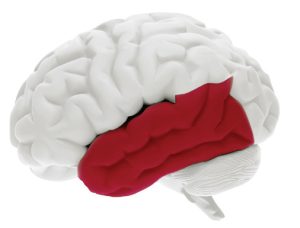 Figure 1: The Temporal Lobe
Figure 1: The Temporal Lobe
This is your temporal lobe; think near your temples and straight back.
- Helps you understand language you hear; listening
- Allows you to respond with language
- Memory retrieval
Tip: You are great at activating this lobe; sometimes too great! Aim for no more than around 40% of instructor monologue so you have time to hear those memories and words your learners recalled while you were speaking.
The Parietal Lobe (Figure 2)
Next, put your hands on the very top of your head. Yes, pause reading for a moment and move your hands to the top of your head. Now tap your head once with each finger, and with each tap say the word “parietal” (Pah-rye-it-ull). I’ll wait.
That was your parietal lobe in action! You read the instructions and then were literally tapping the part of your brain responsible for:
- understanding those instructions.
- making small motor movements.
- knowing where your hands were relative to your head.
- being able to count to one as each finger tapped.
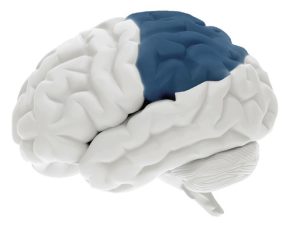 Figure 2: Parietal Lobe
Figure 2: Parietal Lobe
The parietal lobe keeps you moving in the right direction.
- Processes information from your environment; sense of touch as well as sense information from other lobes.
- Helps navigate you; senses where you are and coordinates how you move in that environment.
The parietal lobe is like a versatile utility coach, showing you how to take multiple skills and put them together for optimum performance: sensory processing, spatial awareness and navigation, language processing assistance with other lobes, mathematical operations and number processing.
Tip: Embrace movement. Incorporate it into your learning activities, whether it’s creating stations, using tools and resources, standing up and writing, drawing a picture or having learners build Jenga towers while recalling key data points.
For virtual training, ask them to stand, write keywords in the air, toss a pen back and forth or draw a picture while sharing ideas or reporting out from breakout groups.
The Occipital Lobe (Figure 3)
Primarily, the occipital lobe is the brain’s visual processing center. It’s like the director of a movie, interpreting the images captured by our eyes. But here’s where it gets fascinating: when we imagine something, this lobe doesn’t just sit idle. Instead, it becomes an active participant in the creation of mental images.
When we ask someone to imagine themselves doing something or what the future might look like, it is the occipital lobe that is activated. When someone tells us a story and we are imagining what happened, it is the occipital lobe again. Building those mental images helps us make sense of what we are seeing and hearing.
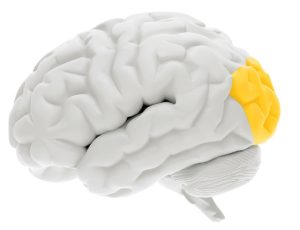 Figure 3: The Occipital Lobe
Figure 3: The Occipital Lobe
The occipital lobe houses your visual processing center.
- Recognizes faces, places and pictures.
- Large role in recognizing written language (reading).
- Memory storage and recall.
- Visualization of mental imagery
While the occipital lobe is crucial in forming these mental images, it doesn’t work alone. It’s part of a team, with other areas like the frontal lobe (the brain’s strategy center) and the temporal lobe (the memory archive) contributing to the richness of imagination.
Tip: Always use a clear visual when presenting an idea. Approximately 80% of information is transferred visually, which is why we love infographics, glossy brochures and reading facial expressions. If people have an image in their mind, it’s much easier to recall the idea attached to it. When hearing from learners, ask for a visual description, e.g., “What would that look like?”
The Prefrontal Cortex (Figure 4)
Picture the prefrontal cortex as a character with a sharp suit, a keen eye and a chessboard in front of them. It’s calm, composed and always thinking about the next move, keeping your impulses in check, like a wise mentor who knows that our emotions guide our initial responses and says, “Let’s think this through before acting.”
The role of the prefrontal cortex includes decision-maker, planner and organizer. It also manages your impulse control and acts as your social conductor and problem-solver. It decides what is important to remember, and what to forget.
Tip: Before asking learners to demonstrate a skill, allow the learner time to process each new piece of content you’ve introduced by asking a critical thinking question that encourages both recall and a growth mindset, e.g., “What did you already know, but now see differently?”
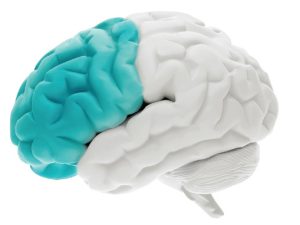 Figure 4: The Prefrontal Cortex
Figure 4: The Prefrontal Cortex
The prefrontal cortex is in the frontal lobe and is the thinking part of the brain.
- Critical evaluation of ideas, decision-making and planning.
- Where learning begins as ideas become part of working memory and then transfer to short-term memory, followed by longterm memory while we sleep.
Whole Brain Activation Is the Goal
When we are teaching someone or wanting to communicate our message or ideas for understanding and longterm retention, our goal is to create activities that activate all four learning lobes of the brain. This is how you engage every learner, no matter their learning preference.
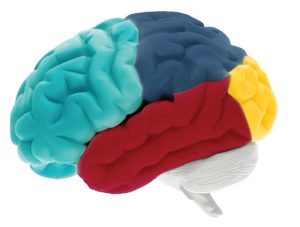 Figure 5: Whole Brain Activation
Figure 5: Whole Brain Activation
The Intersection of Education and Business
Parallel to this in the world of commerce is whole brain selling. The intersection of whole brain learning and whole brain selling lies in their shared foundation: the understanding and engagement of the full spectrum of brain functions.
Both approaches recognize that effective communication – whether in teaching or selling – requires understanding the fundamental way the brain processes information and prefers to communicate.
If you learn to speak brain, you can teach anyone anything.
 Jennifer Little-Fleck is president, CEO and chief medical writer at BrainCelling. Email Jennifer at jennifer@braincelling.com or connect through LinkedIN at linkedin.com/in/jenniferelittle.
Jennifer Little-Fleck is president, CEO and chief medical writer at BrainCelling. Email Jennifer at jennifer@braincelling.com or connect through LinkedIN at linkedin.com/in/jenniferelittle.








